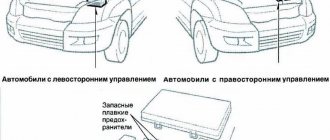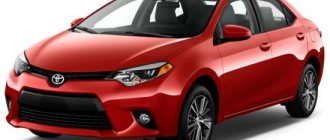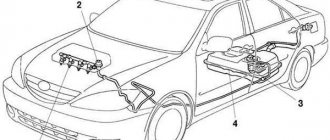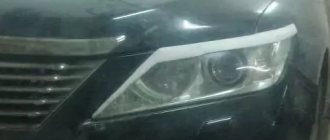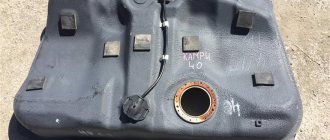The 1996 Toyota Camry belongs to the XV20 generation, which was supplied not only to the Japanese market, but was also offered in North America (modification with left-hand drive). Attempts to bring the model to the European market were unsuccessful, since the car was not in demand. A large number of used cars brought from Japan ended up in Russia.
Brief description of the 1996 Toyota Camry
The development of a new generation of Camry cars with increased body dimensions began in 1991 as part of the 415T product development program. By 1994, the general design of the exterior and interior was approved, and 2 years later sales began in the USA, and then in Japan. A modification with a 5-door station wagon body was supplied to the domestic market, and later a 2-door Solara coupe was produced for North America (the coupe was not offered to Japanese customers).
For the domestic market, the car was designated Camry Gracia (regardless of the body type); at the same time, a Mark II Qualis station wagon was offered, which did not have common parts with the Mark II model cars. The Qualis could be equipped with V-shaped 6-cylinder engines with a volume of up to 3.0 liters.
The appearance of 2 models with an identical body design is associated with the concern’s marketing strategy. The Gracia model was sold through Toyota Corolla Store dealerships, and the Qualis modification was supplied through the Toyopet network.
Repair manual for Toyota Camry / Toyota Camry 1996-
- Repair manuals
- Repair manual for Toyota Camry 1996-2001.
General information about the car.
The production of cars under the Toyota Camry brand began in 1983, when the concern suspended the production of cars of the Corona model range and devoted its efforts to winning over American consumers. What was the further fate of the cars of this brand, and how much time and effort it took Toyota to bypass its main competitor, you will find out in this review. In 1983, the top seller in the United States was the Honda Accord. The first generation of these cars was released back in 1976 in a hatchback body, a year later a sedan was put into production, and in 1981 the second generation of these cars rolled off the assembly line, assembled in America. So, in 1983, Toyota began selling foreign cars of a new class, designed to supplant Honda cars, which were leading in sales in the United States at that time. From this moment on, the rivalry between the two automakers begins. The new Toyota Camry had more advanced technical characteristics than Honda and soon reached the sales level of its competitor. So, in the struggle for consumers, each company tried to improve their cars. As a result, in 1985 Toyota expanded the color range of its cars and added 3 hp. to engine power. And already in 1988, a new, second generation of the Camry series was developed. Among the innovations, it is worth noting the increased engine power, it amounted to 115 hp. and was ahead of Honda by 17 hp, in addition, the developers managed to improve the engine noise insulation, and on top of everything, cars were now produced not with five, but with a four-door body. A year later, new design developments were implemented: a V6 DOHC engine with a volume of 2.5 liters and a power of 153 hp. and an all-wheel drive system. That same year, due to its growing popularity among Americans, a plant was built to produce the Toyota Camry in the United States. Until 1992, no special changes were made to the design of the car, since its popularity was already quite high. But already in 1992, the dimensions of the body were changed (it was made streamlined), the engine could now have a volume of 2.2 liters and a power of 130 hp. It is worth noting that a similar type of engine was installed in models of the DX, LE, XLE series, and for true fans of the brand, an SE series car was released, which had a 3-liter V6 engine with a power of 185 hp, which allowed it to reach speeds of up to 100 km/h in just 8 seconds. The SE package also included sports suspension, long-radius tires, sports seats and a rear spoiler. The DX and LE models were so spacious that they could seat up to seven people. Without false modesty, we can say that 1992 was a year of triumph for the Toyota plant in America, since 75% of Toyota Camry sedans sold in the United States were produced at the Kentucky plant, and 100% of station wagons sold worldwide were also released there.
↓ Comments ↓
1. Instruments and controls
1.0 Instruments and controls 1.1. Right-hand drive vehicles 1.2. Information before driving a car 1.4. Technical characteristics 1.5. Some tips when buying a car
2. Maintenance
2.0 Maintenance 2.2 Toyota Camry/Avalon maintenance schedule 2.3 Primary and secondary checks 2.4 Checking oil and fluid levels 2.5 Checking the condition of tires and tire pressure 2.6 Checking the power steering system fluid level 2.7 Checking the automatic transmission fluid level 2.8 Replacing the engine oil and oil filter 2.9 Inspection and replacement of windshield wiper blades 2.10 Checking, maintaining and charging the battery 2.11 Checking, adjusting tension and replacing the drive belt 2.12 Checking and replacing hoses in the engine compartment 2.13 Checking the cooling system 2.14. Rearranging the wheels 2.15 Checking the brake system 2.16 Replacing the air filter 2.17 Checking the power system 2.18 Checking the differential fluid level (automatic transmission) 2.19 Checking the manual transmission oil level 2.20 Checking the steering and suspension 2.21 Checking the axle shaft covers 2.22 Checking the exhaust system 2.23 Height and free play of the clutch and brake pedals 2.24 Replacing the fuel filter 2.25 Replacing the coolant and flushing the cooling system 2.26 Checking the system that controls the release of fuel vapors 2.27 Replacing the automatic transmission fluid 2.28 Changing the manual transmission oil 2.29 Checking the body fastenings 2.30 Checking and replacing the spark plugs 2.31 Checking and replacing the spark plug wires 2.32 Checking and adjusting the gaps valves 2.33 Replacing the fuel tank filler cap gasket 2.34 Checking and replacing the crankcase ventilation valve
3. Engines
3.0 Engines 3.1. Compression check 3.2. 6-cylinder two-row engines V6 3.0 l 3.3. Engine overhaul 3.4. Engine electrical equipment
4. Cooling system
4.0 Cooling System 4.2 Specifications 4.3 Thermostat 4.4 Cooling Fans 4.5 Radiator and Expansion Tank 4.6 Water Pump 4.7 Coolant Temperature Sensor 4.8 Blower Fan Motor Circuit 4.9 Blower Fan Motor
5. Heating and ventilation
5.0 Heating and ventilation 5.2 Heater and air conditioner control panel 5.3 Heater radiator 5.4. Air Conditioning and Heating Systems 5.5 Air Conditioning Compressor Clutch Circuit 5.6 Air Conditioning Dehumidifier 5.7 Air Conditioning Compressor 5.8 Air Conditioning Refrigerator 5.9 Air Conditioning Evaporator
6. Fuel system
6.0 Fuel system 6.2 Technical characteristics 6.3 Fuel system pressure relief 6.4 Fuel pump and fuel pressure 6.5 Fuel pipes and pipe connections 6.6 Removing and installing the fuel pump 6.7 Fuel pressure regulator 6.8 Fuel gauge sensor 6.9 Fuel tank 6.10 Cleaning and repairing the fuel tank 6.11 Housing air filter 6.12 Accelerator cable 6.13 Electronic fuel injection system 6.14 Throttle 6.15 Fuel line and injectors
7. Exhaust system
7.0 Exhaust system 7.1 Emission control systems 7.2 Technical specifications 7.3 OBD II system 7.4 OBD II computer (Powertrain Control Module) 7.5 Throttle valve sensor 7.6 Manifold absolute pressure sensor 7.7 Mass air flow sensor 7.8 Intake air temperature sensor (IAT sensor) 7.9 Coolant temperature sensor (ECT sensor) 7.10 Crankshaft rotation sensor 7.11 Camshaft rotation sensor 7.12 Power steering pressure contact sensor 7.13 Exhaust gas oxygen sensor 7.14 Knock sensor 7.15 Vehicle speed sensor 7.16 Idle air bypass valve (IAC) -valve) 7.17 Suction channel selection system (ACIS system) 7.18 Crankcase ventilation system 7.19 Recirculation system 7.20 Gasoline vapor recovery system 7.21 Neutralizer 7.22 Three in one - or how to protect the catalyst
8. Transmission
8. Clutch 8.0 Transmission 8.1. Caring for manual transmission 8.2. Automatic transmission
9. Chassis
9.0 Chassis 9.1. Technical characteristics 9.2. Steering 9.3. Half shafts
10. Brake system
10.0 Brake system 10.2 Technical characteristics 10.3 ABS system 10.4 Disc brake pads 10.5 Brake caliper 10.6 Brake disc 10.7 Drum brake pads 10.8 Brake wheel cylinder 10.9 Brake master cylinder 10.10 Hydraulic hoses and tubes 10.11 Bleeding hydraulic drive and brakes 10.12 Vacuum brake booster 10.13 Parking brake pads rear disc brakes 10.14 Parking brake 10.15 Parking brake cables 10.16 Brake light switch 10.17 ABS: natural choice 10.18 Brake system malfunctions
11. Body
11.0 Body 11.2 Vinyl Trim 11.3 Upholstery and Carpets 11.4 Minor Body Damage 11.5 Major Body Damage 11.6 Hinges and Locks 11.7 Windshield and Fixed Glass 11.8 Central Locking 11.9 Hood 11.10 Hood Latch and Lock Cable 11.11 Bumper Decorative Panels 11.12 Front fender 11.13 Trunk lid 11.14 Trunk lid latch and lock 11.15 Fuel tank/trunk lid release cable 11.16 Door trim panels 11.17 Door 11.18 Latch, door lock and handle 11.19 Door glass 11.20 Window lifter 11.21 Mirrors 11.22 Center floor section 11.23 Decorative panels of the front part of the interior trim 11.24 Steering column covers 11.25 Instrument panel 11.26 Windshield frame trim 11.27 Seats 11.28 Storage tray
12. Electrical equipment
12.0 Electrical equipment 12.1. Troubleshooting 12.2. Electrical circuits
Car equipment
The standard equipment of the cars included a fabric-trimmed interior and 4-way adjustable front seats. The instrument panel was made of foam plastic, and the driver faced an analog instrument cluster. The cars were equipped with manually adjustable air conditioning by default, but the dampers in the air ducts were electrically driven. The base was equipped with electric windows and mirrors with a remote adjustment and cleaning system.
Improved modifications had a velor interior (several color options were offered) and were equipped with a radio with a radio and a tape recorder or laser disc player. The speakers were installed in the door frames, and the manufacturer offered speaker systems with additional speakers. For an additional fee, the plant installed a navigation system with a color display. The list of additional equipment included an electric sunroof, 1-zone climate control and an alarm system with a control panel in the ignition key head.
The standard equipment included steel wheels with 205/65R15 tires; improved models had aluminum alloy wheels; designer BBS wheels were offered for an additional fee. Between the front seats there was a center console with an armrest; an ashtray and cup holders for passengers in the rear row of seats were installed in the rear wall.
Make-up mirrors were installed in the sun visors, and the interior was trimmed with panels imitating wood.
Interior
The interior is spacious with plenty of room for front and rear passengers. The seats are soft, although they lack light side support. The seats and door panels are covered with either velor or leather. Sometimes a combined type of cladding is found.
To give the Camry even more status, the center console is made of wood. There is nothing unusual on it - a radio, a climate control unit with a monitor and an ashtray with a cigarette lighter. The driver gets a leather-wrapped 4-spoke steering wheel, behind which is a purely analog instrument panel with adjustable backlighting.
The interior of good trim levels boasted climate control, electrically adjustable front seats, a sunroof, a CD changer, and heated seats.
The trunk is excellent - 518 liters, and for large cargo the rear bench folds in a 60:40 ratio.
Specifications
The car was equipped with a front independent suspension with lower wishbones and a MacPherson strut, in which a shock absorber and a spring with nonlinear stiffness were installed. To increase the stability of the trajectory, a stabilizer was used, and the hinges of the levers were attached to a welded subframe. The steering mechanism was rack-and-pinion type; a hydraulic booster with an engine-driven pump was installed. The steering column was manually adjusted in 2 directions, allowing people of different heights and weights to control the car.
At the rear, a 3-link suspension was used, which allowed the installation of a gearbox and axle shafts. The engine and gearbox were installed transversely under the hood; when using an all-wheel drive system, torque was transmitted to the rear wheels by a driveshaft. The standard fuel tank held 70 liters, the Four modification (with all-wheel drive) had a recess for the shaft, reducing the volume by 5 liters. The basic equipment of the vehicle included gas or oil shock absorbers; a TEMS step-by-step stiffness adjustment system was installed upon request.
Technical specifications:
- length - 4800 mm;
- width - 1785 mm;
- height - 1420 and 1430 mm (for versions with front-wheel drive and all-wheel drive);
- wheelbase - 2670 mm;
- front track - 1545 mm;
- rear track - 1520 mm;
- curb weight - from 1400 to 1510 kg;
- total weight - from 1675 to 1785 kg.
Car engine
Types and parameters of power units:
- The in-line 4-cylinder 5S-FE was considered basic, developing 140 hp. with a working volume of 2163 cm³. The cylinder dimensions (diameter and stroke) were 87 and 91 mm, respectively, the torque reached 191 N*m at 4400 rpm.
- The improved and sports modifications were equipped with a 6-cylinder V-shaped 2MZ-FE with a power of 200 hp. With. with a volume of 2469 cm³. The cylinder diameter is increased to 87.5 mm, and the piston stroke is reduced to 69.2 mm; peak torque of 245 N*m is achieved at 4600 rpm.
Both power units have a 4-valve gas distribution pattern and 2 camshafts in the block heads. An EFI multi-point injection system with an electronic control unit is used to supply fuel.
Gasoline consumption in the combined cycle declared by the manufacturer ranges from 9.8 to 10.2 liters (depending on the type of engine and transmission design).
Technical characteristics of Toyota Camry XV20
| Type | Volume | Power | Torque | Overclocking | Maximum speed | Number of cylinders |
| Petrol | 2.2 l | 131 hp | 196 H*m | 10.4 sec. | 200 km/h | 4 |
| Petrol | 3.0 l | 190 hp | 275 H*m | 9 sec. | 220 km/h | V6 |
Read more
The sedan's engine line consists of two gasoline positions. These are reliable naturally aspirated engines installed on the second Mark, the first Highlander, etc.
- 5S-FE is an in-line 4-cylinder engine with direct injection, producing 131 horsepower with 196 H*m of torque. The engine pulls the 1385-kilogram sedan well, consuming more than 12 liters of gasoline.
- 1MZ-FE is the same 3-liter V6 with conventional multipoint injection. The engine produces 190 horses with 275 units of torque. This is a dynamic installation that consumes more than 16 liters of fuel.
The front-wheel drive car was paired with a 5-speed manual S51 or a 4-speed automatic A140E. The V6 was only sold with an automatic. The suspension was left traditional - independent MacPherson struts all around. The chassis is soft, and the hydraulic booster makes it easy to control. All-round disc brake system with ABS system.
The main feature of the 4-cylinder engine is that it does not bend the valve when the timing belt breaks. Over time, the engine loses its fuel injection pump due to bad gasoline, which also kills the EGR valve. Periodically, in order to avoid floating speed and high fuel consumption, you need to clean the throttle valve with injectors. So the 5S-FE can easily cover more than 300 thousand kilometers.
The V6 Camry XV20 periodically loses the knock sensor, has the same EGR valve and requires periodic cleaning of the throttle body. After a long mileage, the rings and caps become stuck, resulting in high oil consumption. The 1MZ-FE engine is also capable of traveling more than 300 thousand kilometers.
The suspension is reliable and simple in design. The first problems, not counting the crossbar stabilizers, appear after 100 thousand kilometers. The sedan's ball joints run under 150 thousand.
Exterior and interior
The car had a body with smoothed outlines and an elongated front part, equipped with glass optics with halogen lamps. The front bumper was equipped with a decorative trim with a chrome strip; in the lower part there were windows for installing rectangular fog lights. The sides of the body did not have a dedicated belt line; an arch extension was provided on the surface of the front wing and there was a turn direction repeater.
The trim on the front bumper had a visual continuation on the side parts of the doors; a rubber strip protected the paint from damage in parking lots. The car was distinguished by a rear bumper of increased volume, and a small diffuser was located on the lower edge of the casing. The stern optics consists of 2 asymmetrical sections located on the trunk lid and fender. The niche for the license plate complies with the Japanese standard, which complicated the installation of Russian elongated signs (from 2021, a rectangular license plate can be ordered).
The car's interior was distinguished by its increased dimensions (length 1900 mm, width 1460 mm and maximum height 1180 mm); soft plastic and velor were used for decoration. There was an armrest between the front seats, and the rear sofa had a folding central section. The glass from the factory had a green athermal coating that maintained the temperature in the cabin. Depending on the level of equipment, the steering wheel had a plastic rim or wooden inserts.
Camry safety
When developing the car body, high-strength steel elements were introduced into the load-bearing frame; the manufacturer provided programmable deformation zones that made it possible to absorb part of the impact energy. The default braking system used an ABS unit with a controller that regulated the braking forces. The rear-view mirrors had reflective elements with a curved surface, which reduced the dead zone. To improve visibility in the rain, an electric wiper was installed on the rear window (in addition to the standard heating filaments).
The driver and front passenger were provided with seat belts with height adjustment and pyrotechnic tensioners. Front airbags were installed in the steering wheel hub and instrument panel by default; there were no side protective elements in 1996.
The rear sofa was equipped with inertial seat belts for passengers and separate straps for attaching a child seat.
Advantages and disadvantages
Advantages of the car:
- reliability of design;
- possibility of repairs on your own;
- a modification with all-wheel drive is provided;
- large salon;
- good standard sound insulation;
- rich set of options.
Disadvantages noted by owners:
- due to high mileage, wear of power units and transmission components is observed;
- right-hand steering wheel (cars from Europe or the USA are rare in the Russian Federation);
- difficulties with purchasing new original spare parts;
- the appearance of pockets of through corrosion on cars restored after an accident.
Reviews from car owners
Nikolay, 42 years old, Barnaul
In 2014-16 I drove a Camry with right-hand drive and all-wheel drive. The sedan, manufactured in June 1996, was imported into Russia in 2001; at the time of purchase, the mileage on the speedometer was 240 thousand km. In the first winter, I changed all the cooling system pipes and flushed the radiators, then I had to install new power unit mounts and rear suspension arms assemblies with hinges. There were no additional problems, but equipment with increased ground clearance was required, so the car was exchanged for a RAV 4 crossover.
Oleg, 36 years old, Omsk
From time to time I use a Camry sedan with a 2-liter engine and front-wheel drive; a relative brought the car built in 1996 and drove it through customs in 2002. The power of the 140-horsepower engine is enough for dynamic acceleration in the city and outpacing passing traffic on the highway. In the combined cycle, gasoline consumption does not exceed 8-10 liters (depending on the time of year), and there are no problems with spare parts. There are no areas of through corrosion observed; I have adjusted the door locks several times; it is necessary to change the seals in the openings that have lost their elasticity.
TOYOTA CAMRY
Toyota Camry 2.2 AT (1998, Sedan)
Automatic transmission 2164 cm³ Left 322000 km 355000 km 2011 - 2012 Kazakhstan
naiman naiman 05/23/2012:
“Since March 2011, I have been the owner of a TOYOTA Camry 2.2, 1998, LE equipment, American, mileage at the time of purchase was 200,000 miles, which is approximately 322,000 km. I will share my impressions of operation.
The salon really pleased me. Very spacious and soft. There are many small glove compartments, cup holders for the front passengers and cup holders for the rear seats extending out from the tunnel between the front seats. Speedometer in miles in large print and in kilometers in small print. The odometer is also in miles. Impressions from the ride. The car is certainly not for driving. The volume is not the same. But it is economical for a class E car. In the city it consumes 10-11.5, depending on my mood and driving style, on the highway up to 7 liters per hundred (more on that later). It holds the road confidently. The suspension is very comfortable. Small irregularities pass without noticing. Visibility is excellent when moving forward. When moving backwards, the stern is poorly felt due to the slope of the trunk. For me, comfort is more important in a car. I'm not a Schumacher. The Camry more than meets all my requirements. With the front seat fully reclined, there is decent legroom. The width of the set is also sufficient for 3 people in the back seat without problems when driving around the city, but for long trips it’s better for two. Upon arrival it was changed and repaired - I changed all the earrings, front and rear - I raised the rear shock absorber cups by 40mm (4cm). The springs are normal, but the Camry's springs are very soft. The guys at the service station told me that it is easier to raise the cups than to change the springs. Because Replacing the springs will be a scam, because all the springs sag after 4-5 months of using the car. For this reason, the car sagged when rear passengers boarded. After the procedures everything got better. — the car came to me with Russian-made tires, the wheels are metal and also size 195*70*R14. It was definitely decided that I would install titanium wheels with size R15, and I had tires in the garage measuring 195*65*R15, I installed them, they were left over from my old Audi A4 car (more on this car later). You can ride them for another season. I bought the discs at CarCity, I don’t remember which boutique. — changed the front floating silent blocks — changed the ball bearings — changed the steering tips and did the wheel alignment (both front and rear, electronic geometry) Nothing more was required for the chassis. All replacement work was carried out by familiar craftsmen. All these shortcomings were identified when purchasing the car. And a little bit about how I bought a CAMRY 20. Before Camry, I had an Audi A4 model (shit). I drove it for a year, but it broke down almost every 2 weeks. I had to go to CarCity at least 2 times a month, if I was lucky. We won’t talk about this anymore, because... I got rid of this stupid Audi A4. It took a long time to get out of the car, many people looked at it, no one wanted to take it. March 21, 2011 The guys called me and wanted to see the car. We met, they looked, drove it to a service station, lifted it, at that time there were no illnesses, only the box was kicked 2 by 3. In short, I sold it 23-30 at night. I brought the money I received and 6 liters of beer to my father-in-law’s house. We drank beer at night, on the 22nd in the morning relatives came in large numbers and already ate NAURYZ KOZHE. And most importantly, I was left without a rudder. Now we need to look for a car. It was decided that I would take the CAMRI 20 or 25. I searched mainly on the Internet. They came and showed their Camrys. Many were worn out, and those who had cars in good condition broke prices for 11,000 USD. and did not want to give in. Sunday, March 27, I went alone to the Bayanauyl car market, which is along the Kaskelen highway. I only looked at Camry 20-25ki. I went through 25-30 pieces. Of these, I liked 2 cars, price = condition of the car. One asked for 11,000, the other for 10,700. I settled on the second one, broke it down to $9,800, but I didn’t have enough money. And he needs to sell the car URGENTLY, because... he gave another $6,500 as collateral, and promised to give the remaining $8,000 on Monday. He bought a Camry 30. In the end, we didn’t agree on the price, and I went home upset. On Monday I’m sitting at work, the phone rings, the same guy speaks, says he wants to meet. I have cash))). He came to my work and said that he was ready to pay for 8,500, I insisted on exactly 8,000 and they would deregister at my expense, I agree. At the same moment I asked to leave work, we went to deregister. The procedure is familiar to everyone, queues(((I wanted to get at least mirror plates, it didn’t work out in the city, they asked a lot for normal plates. They said in the region there were no problems with this. I got city regular plates. - I immediately replaced the oil in the engine with Castrol 10W40. In a Dextron box. I changed all the filters. Inspection of the timing belt did not require replacement. Pleasant everyday life of operation began. You relax behind the wheel. During the year of operation I covered 31,000 km, the odometer now shows approximately 220,000. There were no serious problems. Only once I stopped at a service station for repairs. I was driving home from work in the evening. There was SMOKE under the hood. I didn’t understand, I lifted the hood, antifreeze was steaming. I got home. In the morning I looked, the top tank had burst, it turns out they were plastic, they replaced it for 22,000 tenge with aluminum ones. In the fall, I decided to install heated mirrors, because rain and snow were ahead. In short, I went to the electricians in Karsiti, they said that they would do it for 15,000 tenge. I sent them further, and I went to the Bayanaul bazaar to buy materials for heating the mirrors. As a result, I bought materials for 3,500 tenge, heated the mirrors, and installed an autonomous switch. After that there were no big problems. There were replacements for the rear pads too, I have drum pads, they changed them ourselves, after a while I changed the front ones too. I try to change the oil every 8000-8500 km, which is approximately every 3 months. And of course it comes with an oil, air and fuel filter. I fill up with 92 gas, sometimes it was 95 at times. Last summer I installed running lights, connected it to the marker, I’ll post a photo. I replaced all the light bulbs on the board, installed gas ones, they shine 5 times brighter, my friends were shocked when they saw it, one also has a Camry, but the board is not comparable. There will be a photo. I also installed parking sensors on both the front (4 pieces) and rear (4 pieces) bumpers. Cool stuff. It works without problems from 2 meters to 30 cm. By the way, I installed all this myself. In the summer I went to Issyk-Kul with my family, the trip was no problem. The traffic police of the neighboring country did not stop))). On the way back we stopped in Bishkek, had lunch, and visited the Dordoi bazaar (I don’t know what they call it correctly). Basically I drove at a speed of 110-120 km/h, the average consumption was, according to my calculations, 6.75 liters per 100 km. I didn't add a drop of oil. I went to Astana twice, once to East Kazakhstan region, to the village of Urjar. Behind Urdzhar there is Lake Alakul, it’s 150 km to get there from Urdzhar. Of these, approximately 100 are new roads. We were driving 2 cars along this road, relatives. Highlander was driving ahead of me, I was behind him. At one point I look at the scoreboard, and there my speed is already over 200 km/h. And he continues to drown. I fell behind him, but kept 200 km/h. Still, I drove with a full interior. God forbid... After this we arrive in the village, I pull out the dipstick from the engine oil, the level has dropped by 150-200 grams per 100 km of driving. Whoa fucking said. Now there’s no harm in raping my beauty. The vacation came to an end, driving around the city began. On an October evening, one idiot caught up with me in an Audi 100, said that he had no money (((I had to apply through insurance, the cops. There was a trial. I received the money a month later. My car is running. The cold has set in, frosts have set in. I decided that I will be repairing in the spring, at first I didn’t even feel like washing the car. Then my eyes got used to it. I gave myself and my KAMRYUKHA a gift for the New Year. I installed an alarm system with the MAGICAR 902 car factory, it never let me down, even in the coldest weather without any problems. Great in winter. thing. In the spring, towards the end of March, I decided that I would buy new summer tires. I scoured the Internet. As a result, on the advice of friends, I bought Chinese TRIANGLUE tires 195*65*15. I sold my used summer tires for $100. The tires are cool, and rain and the track holds up super, I've already gone to Kapchagai several times for work. Recently the timing belt started making noise when starting up, I decided to change the entire timing belt as a set. Since I've already driven 30,000 km and it's not known how long they've driven before me. I bought everything. What's there? I found on the Internet that even if the timing belt breaks, there will be nothing wrong with the engine. Despite this, I DECIDED to change, any day I will have to go somewhere far away. On a 5S-FE engine, when the timing belt breaks or turns, the valve does not bend! In general, as they explained to me, on most TOYOTA engines that end in FE, the valves do not bend. Which are oppressive at GE. I took everything original • timing belt + rollers • front seals • oil pump gasket • pump • 10 liters of antifreeze In the spring I wanted to give my favorite candy KAMRYUKHA a gift. I bought a FULL HD 1920*1080 DVR, it takes great pictures. I have a 107 cm diagonal TV at home. I watched what I filmed on this recorder, it turned out to be a clear video. It's a pleasure to watch. Later I bought a CRUNCH 224B radar detector, a new brand, 2012 model. Works great on the highway too. As I wrote earlier, I went to Kapchagai several times, and every 2 weeks I go to Issyk. Already saved 2-3 times. Sees all radars. Which stand on the highway, beep, chirp for 1-1.5 km, you drive confidently. I recently stopped at a service station, lifted the car, and wanted to see what was going on with the chassis. WE ARE HAPPY, we need to change the ball, floating and rear 2 silent blocks. They immediately started removing them, I went for spare parts, and eventually they replaced the ones listed above. Why don’t these ball and floating ones live long and knock like a Woodpecker. I put the car in for painting. They painted my entire body. I walked for two weeks. It was like an eternity for me. Thank you, my KAMRYUKHA 20, for never leaving me on the road. In the near future I want to buy a GPS navigator, NAVITEL and KazNAVI are praised. They are expensive, there are also cheap navigators on the market, but they say they are of little use. I will take one of them NAVITEL and KazNAVI. I will take the navigator with a video input to connect the rear view camera, I will also take the camera and install it myself. And then there are plans to make lighting for the feet; in general, I’ll take on the interior of my Camry -20. I’ll post the photo on my email later. If you haven’t finished writing something or have written a lot, don’t judge strictly, if you have questions, you can write to my email -» expandcollapse

